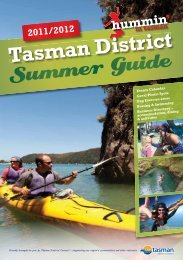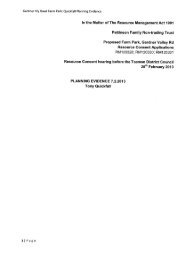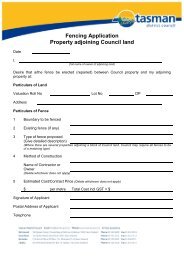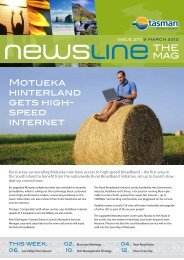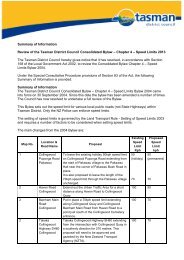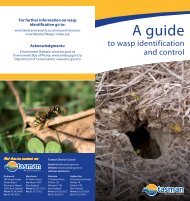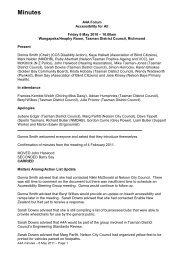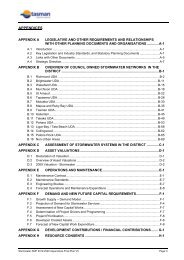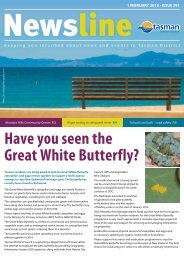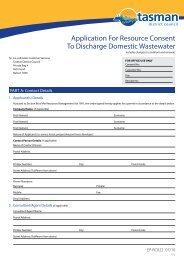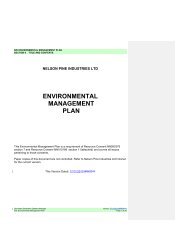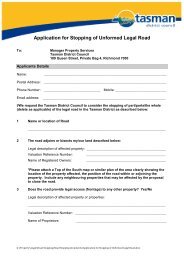Abel Tasman Foreshore Scenic Reserve Draft Management Plan
Abel Tasman Foreshore Scenic Reserve Draft Management Plan
Abel Tasman Foreshore Scenic Reserve Draft Management Plan
You also want an ePaper? Increase the reach of your titles
YUMPU automatically turns print PDFs into web optimized ePapers that Google loves.
ecreational use and access that is relatively high. But there is a clear intention to<br />
provide a predominantly natural visitor experience while still providing for easy<br />
motorised and non-motorised vessel access to the <strong>Abel</strong> <strong>Tasman</strong> coast. Other<br />
important qualities and visitor experiences also need to be protected, such as:<br />
naturalness, including natural quiet; a sense of history; and an ability to appreciate<br />
the natural environment. The balance between use and protection of the reserve<br />
permeates this management plan and guides the visitor management approach,<br />
Recreational Zones and concession management regimes described below and in the<br />
following sections.<br />
Local context<br />
<strong>Tasman</strong> District Council seeks to provide recreation opportunities which meet the<br />
expressed needs and aspirations of present and future communities. <strong>Tasman</strong> District<br />
Council manages a number of reserves, such as esplanade, recreation and local<br />
purpose reserves, including several reserves adjacent to <strong>Abel</strong> <strong>Tasman</strong> <strong>Foreshore</strong><br />
<strong>Scenic</strong> <strong>Reserve</strong> (see Appendix 2). <strong>Tasman</strong> District Council’s objectives for the<br />
provision and management of reserves are contained in the <strong>Tasman</strong> District<br />
Recreation Strategy (1996) and in reserve management plans.<br />
6.1.1 Access and use<br />
The reserve is used for access and for recreational activities by visitors to the<br />
national park, and by residents of and visitors to private landholdings. The reserve is<br />
also a destination for picnics, or a base for boating activities. The Coast Track within<br />
the adjoining national park is the busiest Department of Conservation multi-day<br />
track in the country, receiving approximately 150,000 visitors a year. More visitors<br />
visit the reserve from the sea (by boat, kayak or other vessels) than from the land (by<br />
walking), and over 90% of visitors to the national park use the coastal environment.<br />
The beaches, and the Coast Track within the adjoining national park, are the main<br />
attractions for visitors. During the busiest part of the summer holiday season there<br />
are about 2000 people entering the southern part of the adjacent national park per<br />
day, most of whom are likely to visit the reserve. There are approximately 1200<br />
visitors to Totaranui per day at the height of summer, most also using the reserve.<br />
From late December to early February Totaranui is full to capacity: 850 visitors per<br />
night in the campground; 40 in the Great Walk campsite; and 40 in Ngarata<br />
Homestead. Data for visitor use of the foreshore associated with the adjacent private<br />
land (e.g. Torrent Bay/Rakauroa and Awaroa) are not available.<br />
Most areas in the reserve, including some that are not readily accessible on foot from<br />
the Coast Track, are accessible from the sea by commercial vessels, freedom kayak<br />
rentals, canoes, private vessels and bareboat charters. The reserve is also accessible<br />
by vehicles from road-ends at Wainui Inlet, Totaranui, Awaroa Inlet and Marahau,<br />
and by foot from the adjacent national park or private land. Commercial vessel and<br />
road transport services link with other regional transport services to places such as<br />
Nelson and Takaka. Marahau and Kaiteriteri are the major departure points for<br />
commercial vessels providing transport services into the reserve. Kaiteriteri,<br />
Marahau, Totaranui and Nelson are also launching points for private vessels.<br />
Use is highly seasonal with January, the busiest month, accounting for more than<br />
20% of annual use. Overall, about 80% of use occurs in the six summer months<br />
(November to April). The vast majority of visitors use the reserve as part of a day<br />
trip. Most visitor activity occurs along the coast between Marahau and Totaranui as<br />
6. People’s benefit and enjoyment 41



